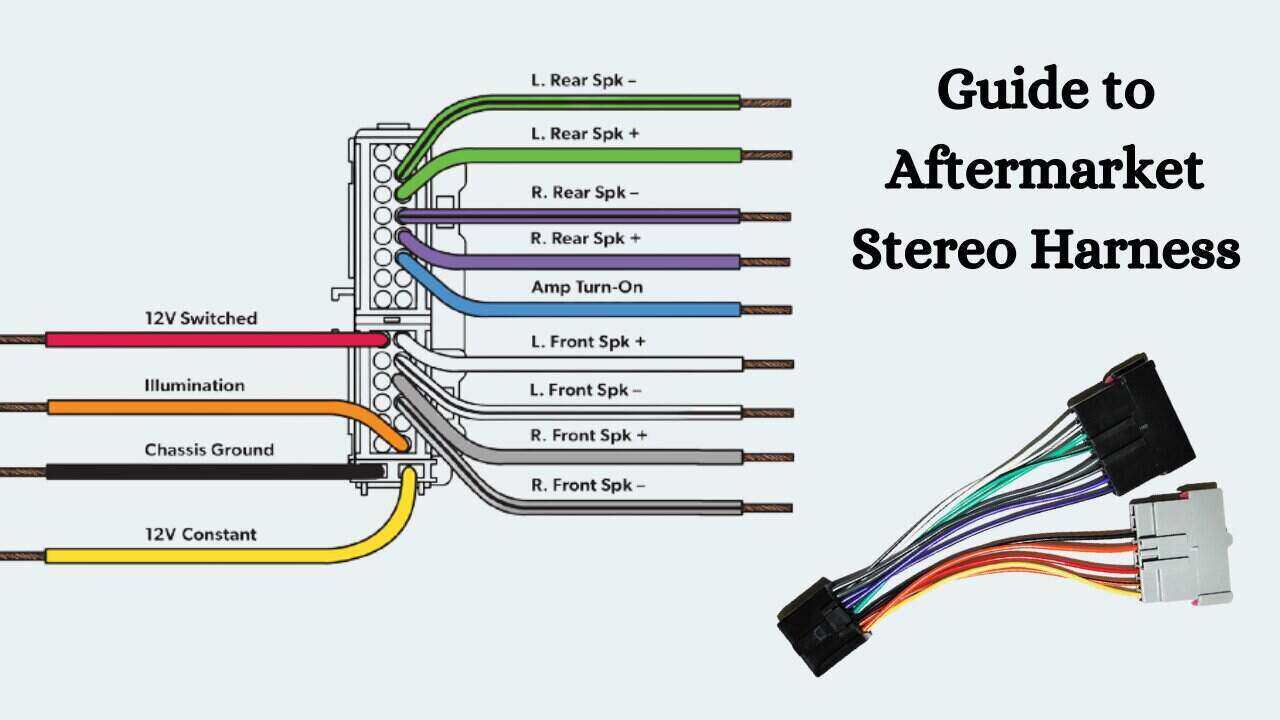Decoding the Rainbow: Your Guide to Car Audio Wire Colors
Ever peered behind your car stereo and felt a surge of confusion looking at that tangle of colorful wires? Don't worry, you're not alone. Understanding car audio wire colors is crucial for any car audio enthusiast, whether you're installing a new system, troubleshooting a problem, or simply upgrading your existing setup.
Navigating the world of car stereo wiring can feel like deciphering a secret code, but it doesn't have to be. This guide aims to demystify the meaning behind those vibrant hues, turning a potentially daunting task into an empowering experience. Mastering the language of car audio wire colors is the key to achieving that perfect, customized sound you crave.
The standardized car audio wire color code emerged as the car audio industry grew. Before standardization, figuring out automotive wiring could be a nightmare, with each manufacturer using their own system. This made installations incredibly time-consuming and prone to errors. The adoption of a common color code streamlined the process, making it significantly easier for both professionals and DIY enthusiasts to work with car audio systems.
The importance of understanding these color codes cannot be overstated. Incorrect wiring can lead to a variety of issues, from a non-functional system to blown fuses and even damage to your car's electrical components. Knowing which wire performs which function is essential for ensuring proper installation and preventing costly mistakes. By learning the basic principles of car audio wiring, you can save yourself time, money, and frustration.
One of the biggest challenges related to car audio wiring colors is the occasional deviation from the standard code. While most manufacturers adhere to the standard, there can be exceptions. This underscores the importance of always double-checking your car's specific wiring diagram before making any connections. Having a reliable wiring diagram will prevent mishaps and ensure your car audio system performs optimally.
For instance, the constant 12V power wire is typically yellow, providing power to the head unit even when the ignition is off. The ignition-switched 12V power wire, usually red, powers the head unit only when the car is on. The ground wire, typically black, completes the electrical circuit. Speaker wires come in pairs, often with a solid color and a striped counterpart for positive and negative connections.
One benefit of understanding these colors is the ability to troubleshoot problems effectively. If your head unit isn't powering on, you can quickly check the yellow and red power wires. Another benefit is the ease of installation. With a clear understanding of the color codes, connecting your new stereo becomes a straightforward process. Finally, knowing the correct wiring allows you to expand your system easily, adding amplifiers, subwoofers, and other components without guesswork.
For a successful car audio installation, start by gathering the necessary tools and equipment, including wire strippers, crimpers, and a multimeter. Next, consult your car’s wiring diagram. Disconnect the negative battery terminal for safety. Then, connect the wires according to the color code and diagram. Finally, reconnect the battery and test the system.
Advantages and Disadvantages of Standardized Wiring
| Advantages | Disadvantages |
|---|---|
| Simplified Installation | Occasional Deviations from Standard |
| Easier Troubleshooting | Need for Car-Specific Diagrams |
| Universal Compatibility (mostly) | Potential for Confusion with Aftermarket Wiring |
Best Practices:
1. Always disconnect the negative battery terminal before working on your car's electrical system.
2. Use a multimeter to verify the function of each wire before making connections.
3. Use high-quality connectors and crimp them properly to ensure a secure connection.
4. Consult your car’s wiring diagram.
5. Secure all wiring to prevent rattling and potential shorts.
FAQs:
1. What does a red car audio wire typically represent? - Ignition-switched power.
2. Why is the ground wire important? - Completes the electrical circuit.
3. What if my car's wiring doesn't match the standard code? - Consult your car's wiring diagram.
4. What gauge wire should I use for speaker connections? - Depends on the power of your system, but 16 or 14 gauge is common.
5. Can I tap into existing wiring for my new stereo? - Yes, but be sure to use proper connectors and avoid overloading circuits.
6. What should I do if I blow a fuse? - Replace it with the correct amperage fuse and check for shorts in the wiring.
7. Where can I find a wiring diagram for my car? - Owner's manual or online resources.
8. What color are the speaker wires usually? - Varied pairs, often with a solid color and a striped counterpart.
In conclusion, understanding car audio wire colors is essential for any car audio project. From simple stereo replacements to complex system upgrades, knowing the function of each wire ensures a smooth and successful installation. While the standardized color code simplifies the process greatly, always remember to double-check your car’s specific wiring diagram to account for any variations. By mastering the language of car audio wire colors, you unlock the potential to create a truly personalized and enjoyable listening experience in your vehicle. Embrace the rainbow of wires and enjoy the journey of building your perfect car audio system. The knowledge gained from understanding car audio wiring will not only empower you to take control of your car’s sound but will also allow you to appreciate the intricate workings behind the music you love.
Designing fairytales the magic of vector blanca nieves png
Keep your mercruiser purring the ultimate guide to marine oil filters
Dominate your league espn fantasy football pick strategies














